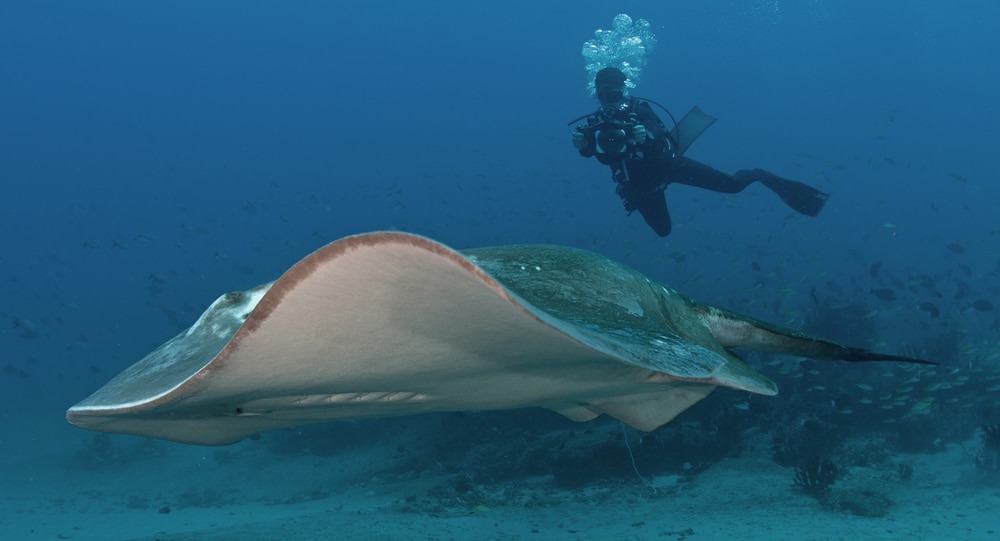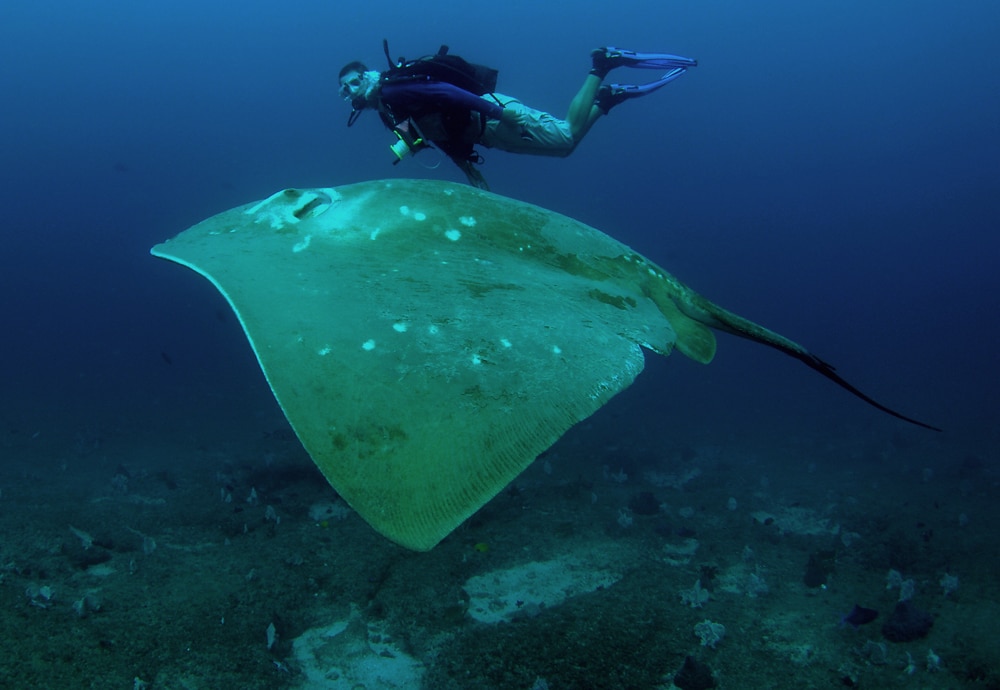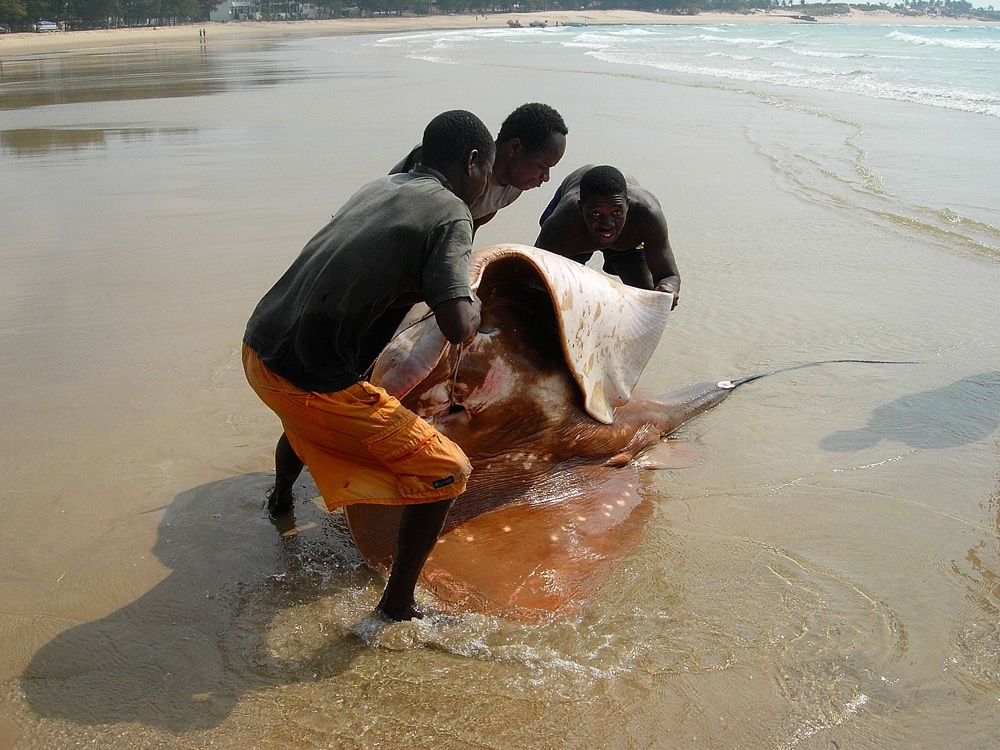Marine Life & Conservation
First study of world’s largest marine stingray reveals long-distance migration

 Scientists use images and videos submitted by tourists to track rare species in Africa
Scientists use images and videos submitted by tourists to track rare species in Africa
Smalleye stingrays are the largest marine stingrays on record, reaching disc widths of up to 222 cm, and yet almost nothing is known about them. Scientists from the Marine Megafauna Foundation have for the first time used photo IDs to study this elusive animal in southern Mozambique, one of the only locations where it is regularly seen in the wild. Their findings were published in the journal PeerJ.
“We reported the first sightings of smalleye stingray in 2004 and have since been racing against the clock to learn more about their ecology before it is too late”, said Dr Andrea Marshall, co-founder and principal scientist of the Marine Megafauna Foundation. 31 percent of the world’s sharks and rays are threatened with extinction according to the IUCN Red List of Threatened Species ‒ due to lack of scientific effort and information, it has not been possible to evaluable the conservation status of smalleye stingrays to date. “This species of ray is likely in trouble too but we can’t protect what we don’t know much about. Our study is an important first step in understanding more about the animal’s ecology and behaviour“, she added.
“These mysterious giants are thought to be patchily distributed across the Indian Ocean and Western Pacific, but southern Mozambique is probably the best location to encounter them on inshore reefs”, Marshall added.
The marine biologists tested whether photographs of the stingrays’ (Megatrygon microps) white dorsal spots could be used to distinguish and track individuals over long periods.
“Through local dive centers, we called on tourists to help us collect images of this solitary stingray. Fortunately for us, southern Mozambique and its rich marine life attract many passionate scuba divers, most of which own GoPros or other lightweight cameras and will happily make their images and footage available for research”, said Atlantine Boggio-Pasqua who volunteered with the Tofo-based foundation.
She added: “Their contributions proved immensely valuable, we managed to gather more than 140 photographs suitable for comparison and identification, with some images dating as far back as 2003.”
The team was able to visually identify 70 different individuals, including 15 that had been seen on several occasions in the area. The dorsal spot patterns looked unchanged over the years indicating they may be permanent markings like in manta rays.
Boggio-Pasqua said: “Smalleye stingrays may look intimidating at first glance with their large, razor-sharp tail spines, but they’re actually really charismatic and easy to approach. We hope to receive many photo and video contributions from citizen scientists in future. They could tell us more about the species’ habitat preference as well as feeding and cleaning behavior.”
The encountered stingrays were often spotted at cleaning stations where reef bannerfish and other small fish appeared to be removing parasites from the rays’ skin.
The photographic study also provided a glimpse into the migratory behaviour of Megatrygon microps. Some individuals traveled hundreds of kilometers along the coastline, including a near-term pregnant female which traveled from Tofo to the Bazaruto Archipelago and back (200km in a minimum of 102 days and a total 400km return trip). She returned to Tofo, no longer visibly pregnant, suggesting this individual had pupped during her journey.
This proved to be the longest straight-line distance ever recorded for any species of whiptail stingrays (Dasyatidae family). Unlike other stingrays, smalleye stingrays are rarely seen resting on the seabed and are thought to be semi-pelagic.
Smalleye stingrays are likely under threat from increasing fishing pressures. Targeted and incidental catch in coastal gillnets and industrial purse seiners operating offshore are an ongoing issue in Mozambique.
“There are so many questions that remain unanswered about this rare species. Where do they live, how fast do they mature and how do they reproduce? Filling these knowledge gaps is crucial to figuring out how to protect them properly in Mozambique and other parts of the Indian Ocean”, concluded Dr Marshall.
Addressing the lack of available data will eventually allow scientists to formally assess the species’ conservation status in the IUCN Red List and inform management practices.
The study by Atlantine Boggio-Pasqua, Anna Flam and Andrea Marshall, titled ‘Spotting the “small eyes”: using photo-ID methodology to study a wild population of smalleye stingrays (Megatrygon microps) in southern Mozambique’ is published in the journal PeerJ on 11 June 2019 and is freely available here.
For more information about the work of the Marine Megafauna Foundation visit their website by clicking here.
Marine Life & Conservation
Paul Watson Released as Denmark Blocks Japan’s Extradition Bid

Renowned anti-whaling activist Paul Watson has been released from custody in Greenland after spending five months in detention. Denmark’s Justice Ministry rejected Japan’s request for his extradition, citing insufficient guarantees that his time already served in custody would be credited against any potential sentence.
The 74-year-old Canadian-American was arrested on July 21 in Nuuk, Greenland’s capital, when his ship docked to refuel. His arrest was based on a 2012 Japanese warrant related to a 2010 encounter in Antarctic waters. Japan alleged Watson obstructed operations and caused damage to a whaling research ship during efforts to disrupt illegal whaling. Watson has consistently denied these claims, maintaining his commitment to marine conservation.
Denmark, which oversees extradition matters for Greenland, concluded that while the legal conditions for extradition were met, the lack of assurances from Japan regarding time-served credit made extradition untenable.
In a video shared by his foundation, Watson expressed gratitude and relief, saying, “After five months, it’s good to be out… and good to know they’re not sending me to Japan.” He added that the most difficult part of his time in custody was being separated from his two young sons.
Watson is a pioneering figure in marine conservation, known for founding the Captain Paul Watson Foundation in 2022 after decades of activism with the Sea Shepherd Conservation Society. His bold efforts to defend marine life have earned him widespread support, including from celebrities and conservationists. His work has also been featured in the acclaimed reality TV series Whale Wars.
Watson’s lawyer, Jonas Christoffersen, praised the decision, stating, “We are happy and relieved that Paul Watson is now free.” He added that Watson is eager to reunite with his family and continue his vital work.
The arrest occurred while Watson’s vessel, the M/Y John Paul DeJoria, was en route to the North Pacific with a team of 26 volunteers to intercept a Japanese whaling ship. His foundation described the arrest as politically motivated and emphasized that Watson’s actions were focused on ending illegal whaling practices.
Japan resumed commercial whaling in 2019 after leaving the International Whaling Commission, asserting that whale meat is a cultural tradition. Conservationists, however, continue to challenge these practices, highlighting their impact on marine ecosystems.
Despite the challenges, Watson remains steadfast in his mission to protect marine life and bring attention to whaling practices. His dedication to ocean conservation has made him a globally respected advocate for the environment.
Marine Life & Conservation
12 Days of Zero-Waste Fish-mas

This holiday period, the Marine Conservation Society, the UK’s leading ocean membership charity, invites you to make some simple changes to eating fish this Christmas to help our seas.
Dr Kenneth Bodles, Head of Fisheries and Aquaculture at the Marine Conservation Society, said, “During the festive season, our consumption increases, but so does waste. Sustainability isn’t just about where food comes from – it’s also about how you use it. By reducing waste and making the most out of your seafood, you’re not only taking steps to be more ocean-friendly, but can also help to cut costs during what is often one of the most expensive times of the year”.
The Marine Conservation Society has compiled twelve tips on how to consume seafood sustainably with zero-waste this Christmas:
Buy whole fish instead of fillets
Instead of fillets, consider buying whole fish such as salmon, hake, or lemon sole. By adopting a “nose to tail” approach with cooking, whole-baked fish not only feeds a crowd, but also helps to minimise waste and maximise sustainability by using up every part of the animal, including bones, skin, and fat.
Make fish stock
Leftover fish bones or shells can be put to good use by boiling them to make a nourishing fish stock or bisque. This can be frozen and preserved for later use and makes for a flavourful base in a soup.
Make your own fish pâté
Avoid waste by turning leftover fish, such as smoked mackerel or salmon, into a delicious pâté by blending with cream cheese and lemon. Perfect when paired with crackers.
The sustainability of salmon and mackerel varies depending on where and how it is caught or farmed. For more information on green-rated options, check the charity’s Good Fish Guide.
Buy frozen
By purchasing seafood that is frozen or vacuum-packed, this helps to reduce waste by extending the shelf life of your food.
Fish pie
If you’re wondering what to do with leftover cooked fish, why not opt for a classic fish pie with mashed potatoes, leeks, and a cheesy sauce? A sure crowd pleaser on Boxing Day.
Use the head
Don’t forget the fish head! The meat is incredibly tender and flavourful. The charity recommends a cod’s head curry or recreating Fallow’s renowned cod’s head in siracha butter.
By stretching your ingredients further, not only is this a more sustainable way to enjoy seafood, but also cost-effective by repurposing leftovers and cooking creatively.
Boxing Day brunch
Mix leftover kippers or smoked salmon with scrambled eggs for a tasty, zero-waste, Boxing Day brunch.
For best choice, make sure you buy kippers, or herring, from the North Sea and the North Irish Sea.
Zero-waste storage
A top tip from the Marine Conservation Society to avoid waste is freezing fish offcuts to save for future use.
Crisp up the skin
Even leftover fish skin can be turned into a quick savoury snack by crisping it up in an air fryer with a little olive oil and salt.
Anchovies two ways
Leftover anchovies can either be blended with butter to make a delicious anchovy butter or tossed into pasta for a hit of umami flavour.
The charity recommends opting for anchovies caught in the Bay of Biscay for best choice.
Fishcakes
For an easy, zero-waste meal, leftover seafood trimmings can be mixed with mash and fried in breadcrumbs to make fishcakes.
Pickled mussels
Try pickling mussels in 1:1 vinegar and water, with a dash of sugar for a sustainable, zero-waste snack that can be enjoyed well beyond the festive season.
Mussels farmed in the UK are a seafood superhero. Grown using low-impact methods and harvested by hand, they get all the food they need from the sea around them. This makes them one of the most sustainable, ocean-friendly, and cost-effective seafood options.
Players of People’s Postcode Lottery have raised £6.6M towards the Marine Conservation Society’s vital work in making seafood more sustainable.
Laura Chow, Head of Charities at People’s Postcode Lottery, said: “Fish is a festive favourite for many, but making sustainable choices when it comes to how we buy and eat seafood makes all the difference for our ocean. Support from players of People’s Postcode Lottery has helped the Marine Conservation Society further its sustainable seafood work, so that we can all enjoy healthier, better protected seas.”
The Marine Conservation Society encourages you to make sustainable seafood choices a year-round habit, not just for Christmas. To check how sustainable the seafood on your plate is, you can visit the charity’s Good Fish Guide. The Guide helps consumers and businesses identify the most sustainable seafood using a simple traffic light system, based on where and how species are caught or farmed. Green is the best choice, amber means improvements are needed, and red indicates fish to avoid buying.
Zero-waste gift idea
Why not embrace a zero-waste Christmas by gifting a membership to support marine conservation? It’s a meaningful, low-waste gift that helps protect our ocean for generations to come. Memberships start from as little as £5 a month – the price of a sandwich and drink from your local coffee shop.
Find the latest sustainable seafood advice for wild-caught and farmed seafood on the Good Fish Guide, downloadable to your phone from www.mcsuk.org/goodfishguide.
-

 News3 months ago
News3 months agoIconic SS United States to become the World’s Largest Artificial Reef
-

 Blogs2 months ago
Blogs2 months agoScubaverse Christmas Gift Guide 2024: Day 4
-

 News2 months ago
News2 months agoSanta Divers take the Plunge for Charity
-

 Blogs2 months ago
Blogs2 months agoScubaverse Christmas Gift Guide 2024: Day 1
-

 News3 months ago
News3 months agoDiscover Turquoise Divers and Media Luna Beach & Dive Resort: A Premier Diving and Relaxation Destination in Roatan
-

 Blogs2 months ago
Blogs2 months agoScubaverse Christmas Gift Guide 2024: Day 5
-

 Blogs2 months ago
Blogs2 months agoScubaverse Christmas Gift Guide 2024: Day 2
-

 News3 months ago
News3 months agoToucan Diving at Plaza Beach and Dive Resort Bonaire Introduces PADI Mermaid Training





